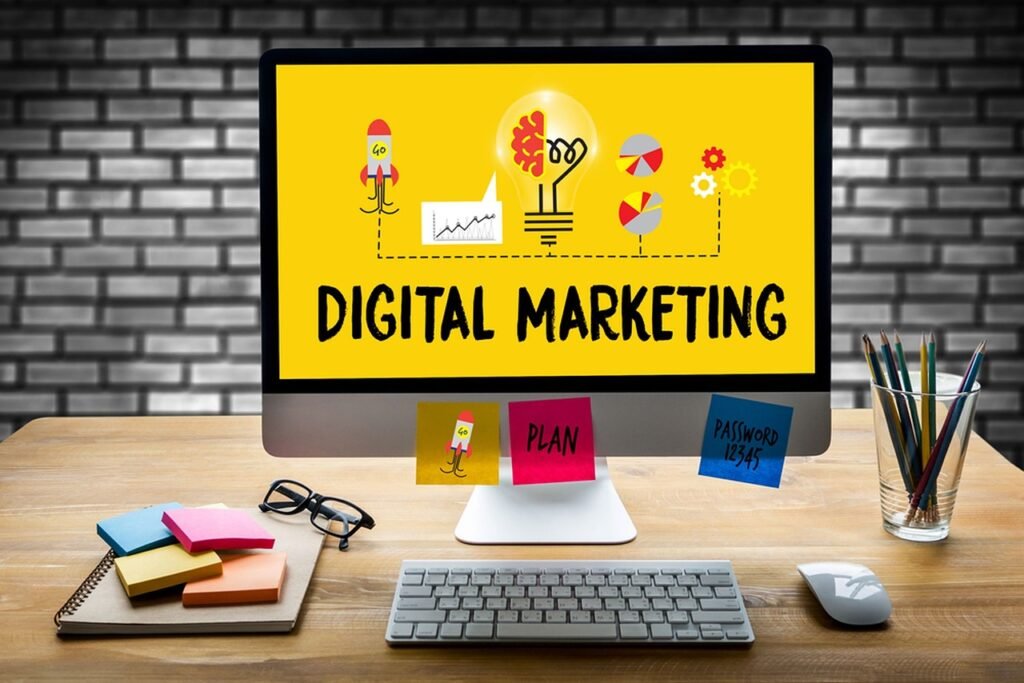In today’s digital-first world, digital marketing has become a crucial part of any business strategy. Whether you’re running a small business, an eCommerce site, or a large enterprise, mastering the fundamentals of digital marketing can be a game-changer. The ability to reach your target audience where they are spending most of their time—online—is essential for growth and sustainability.
In this guide, we will explore what digital marketing is, its various components, its impact on business, and how you can get started with practical steps. By the end of this article, you’ll understand how digital marketing can help grow your business and which strategies can set you up for success.
What is Digital Marketing?

Digital marketing refers to all marketing efforts that utilize electronic devices and the internet. This includes a wide range of tactics, such as search engine optimization (SEO), content marketing, social media marketing, email marketing, and pay-per-click (PPC) advertising, among others. Unlike traditional marketing methods (TV ads, billboards, print media), digital marketing offers the advantage of directly reaching specific customer segments and tracking measurable results.
Types of Digital Marketing
- Search Engine Optimization (SEO): SEO involves optimizing your website to rank higher on search engine results pages (SERPs) organically. By using keywords, creating high-quality content, and ensuring a seamless user experience, SEO helps you attract more visitors to your site without paying for ads.
- Content Marketing: Content marketing focuses on creating valuable content that educates or entertains your target audience. This could be in the form of blog posts, videos, infographics, or podcasts. The goal is to build trust and authority, which, in turn, drives engagement and conversions.
- Social Media Marketing: Social media marketing utilizes platforms like Facebook, Instagram, LinkedIn, Twitter, and TikTok to engage with customers, promote products or services, and drive traffic to your website. It’s also a great tool for community building and brand awareness.
- Email Marketing: Email marketing is the practice of sending personalized emails to potential or current customers. It’s one of the most cost-effective forms of digital marketing and helps nurture relationships with your audience.
- Pay-Per-Click (PPC) Advertising: PPC allows businesses to place ads on search engines like Google or on social media platforms and only pay when someone clicks on the ad. This method offers quick results, especially when targeting specific keywords or demographics.
- Affiliate Marketing: Affiliate marketing involves partnering with third parties (affiliates) who promote your products or services in exchange for a commission on sales.
- Influencer Marketing: This strategy leverages influencers (social media personalities with a large following) to promote your products or services. This is especially effective in industries like fashion, beauty, and technology.
The Importance of Digital Marketing
The importance of digital marketing has skyrocketed, particularly as more people turn to the internet for information, shopping, and entertainment. Here are a few reasons why digital marketing is vital for businesses today:
- Reach a Larger Audience: With over 4.9 billion internet users worldwide, digital marketing helps you expand your reach far beyond what traditional marketing allows.
- Target Specific Customers: Tools like Google Ads, Facebook Ads, and SEO allow you to target your marketing efforts based on user behavior, demographics, and preferences.
- Cost-Effective: Digital marketing often has a lower cost than traditional marketing channels like TV and print. You can start with a small budget and scale up based on results.
- Measurable Results: With analytics tools like Google Analytics, you can measure the performance of your campaigns in real-time and adjust strategies accordingly.
- Build Relationships: Digital marketing fosters direct communication with customers through social media, email, and online forums, helping to build trust and loyalty.
The Impact of Digital Marketing on Businesses
The effects of digital marketing on businesses have been profound. Let’s explore a few key areas where it is making the most significant impact:
1. Enhanced Customer Engagement
With platforms like social media, businesses can now engage directly with their customers. Whether through comments, direct messages, or social media polls, the ability to communicate instantly with your audience has transformed the customer-business relationship. Engaging content allows brands to build communities, create two-way conversations, and encourage loyalty.
2. Data-Driven Marketing
One of the biggest advantages of digital marketing is the ability to use data to make informed decisions. Data analytics tools allow businesses to monitor customer behavior, identify what’s working and what’s not, and fine-tune their marketing strategies accordingly. This leads to better targeting, higher conversion rates, and more efficient use of resources.
3. Increased ROI
Compared to traditional marketing, digital marketing often provides a higher return on investment (ROI). By targeting specific audiences and tracking campaign performance, businesses can allocate their budgets more effectively, resulting in better outcomes at lower costs.
4. Global Reach
Digital marketing has made it possible for even small businesses to reach a global audience. With an effective SEO strategy or a viral social media post, businesses can go from being local brands to international names without needing to invest heavily in physical infrastructure.
5. Personalization
Personalization is one of the most powerful tools in digital marketing. By collecting data about users’ preferences and behavior, businesses can create tailored experiences for customers. For instance, personalized email campaigns or product recommendations based on past purchases can significantly increase conversion rates and customer satisfaction.
How to Grow Your Business with Digital Marketing: Step-by-Step Guide
If you’re just starting out or looking to enhance your current digital marketing efforts, here are some easy steps you can follow to grow your business:
Step 1: Build a Strong Online Presence
The first step in any successful digital marketing strategy is to create a solid online foundation. This starts with your website, which should be professional, user-friendly, and mobile-optimized. Make sure that your website clearly communicates who you are, what you offer, and how visitors can engage with your business.
Key Actions:
- Invest in a quality website with easy navigation.
- Optimize your site for mobile users.
- Add strong calls to action (CTAs) that guide visitors to the next step, such as signing up for a newsletter or making a purchase.
Step 2: Leverage SEO
To attract organic traffic, your website needs to rank well on search engines like Google. This is where SEO comes into play. By optimizing your website content for relevant keywords, you can increase your visibility on search engines and drive more traffic.
Key Actions:
- Research and incorporate relevant keywords into your website’s content.
- Focus on creating high-quality, valuable content that answers your audience’s questions.
- Optimize your website’s structure and load time for better user experience.
Step 3: Engage on Social Media
Social media is one of the most effective channels for building your brand and engaging with customers. Start by identifying where your target audience spends the most time and create a social media strategy that focuses on those platforms.
Key Actions:
- Post consistently on platforms like Facebook, Instagram, LinkedIn, or Twitter.
- Use a mix of content types—images, videos, and written posts—to engage your audience.
- Interact with your followers by responding to comments, messages, and reviews.
Step 4: Implement Email Marketing
Email marketing remains one of the most effective digital marketing channels, particularly for nurturing relationships with your existing customers. By building an email list, you can stay in touch with your audience and share personalized updates, offers, and content.
Key Actions:
- Create lead magnets, such as eBooks or discount codes, to encourage email sign-ups.
- Send regular newsletters that provide value to your audience.
- Segment your email list to send targeted messages based on user preferences or behavior.
Step 5: Use Pay-Per-Click (PPC) Advertising
For businesses looking to see quick results, PPC advertising is a great option. With PPC, you can target specific keywords or audience demographics and only pay when someone clicks on your ad. Platforms like Google Ads and Facebook Ads allow you to create highly targeted campaigns that drive traffic and conversions.
Key Actions:
- Set a clear goal for your PPC campaign, such as driving traffic or generating leads.
- Create compelling ad copy and visuals to attract clicks.
- Monitor and optimize your campaigns based on performance metrics.
Step 6: Create Engaging Content
Content marketing is one of the best long-term digital marketing strategies. By consistently creating valuable, engaging content (like blog posts, videos, and infographics), you can attract and retain your audience while establishing your authority in your industry.
Key Actions:
- Identify your audience’s pain points and create content that addresses their needs.
- Regularly publish blog posts, videos, or social media content.
- Promote your content across various channels to reach a wider audience.
Step 7: Monitor Your Analytics
Digital marketing is all about data. To ensure your efforts are working, it’s important to continuously monitor your campaigns using tools like Google Analytics, Facebook Insights, or your email marketing platform’s reporting features. This will help you understand what’s driving results and what needs improvement.
Key Actions:
- Track key performance indicators (KPIs) like website traffic, conversion rates, and ROI.
- Use data to adjust your marketing strategies and optimize future campaigns.
- Set goals for each campaign and monitor your progress regularly.
Digital Marketing Use Case: Starbucks
To illustrate the power of digital marketing, let’s take a look at Starbucks, one of the world’s most successful brands.
1. Social Media Engagement
Starbucks has mastered the art of social media marketing. The brand consistently shares engaging and interactive content on platforms like Instagram, Twitter, and Facebook. From user-generated content to seasonal promotions, Starbucks keeps its audience involved in the brand’s journey.
2. Mobile App and Loyalty Program
Starbucks’ mobile app is an example of successful digital marketing. It offers customers the ability to place orders, collect rewards, and receive personalized offers, enhancing customer loyalty. The app’s intuitive design and personalized experience have been key factors in retaining customers and driving revenue.
3. Email Marketing
Starbucks also excels in email marketing, sending out personalized offers, promotions, and product updates. These emails often include limited-time deals or reward bonuses, encouraging users to visit the store or order through the app.
Takeaway: Starbucks’ digital marketing strategy shows how combining social media engagement, mobile optimization, and personalized email marketing can build customer loyalty and increase sales.
Conclusion
Digital marketing has revolutionized the way businesses connect with their audiences and grow their brands. From increasing visibility to building customer loyalty, digital strategies offer limitless potential for business growth. By creating a strong online presence, leveraging SEO, engaging on social media, and using data to drive decisions, you can unlock the full power of digital marketing.
Whether you’re just starting out or looking to scale your business, digital marketing is essential for success in today’s competitive landscape. Begin your digital marketing journey today, and watch your business thrive!
